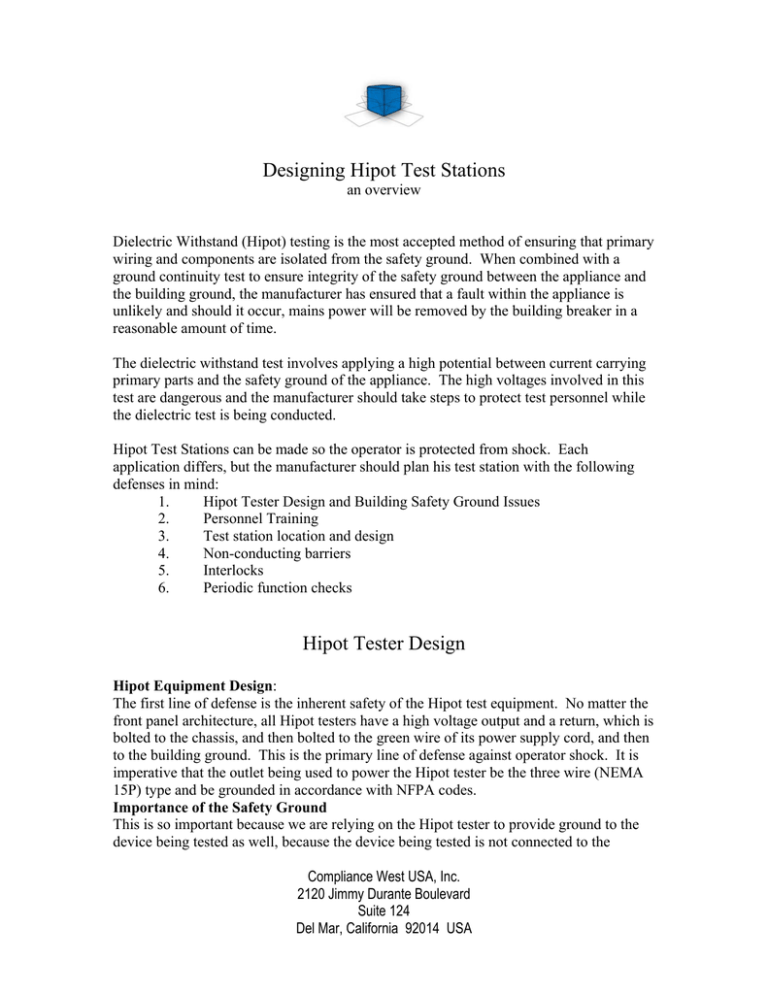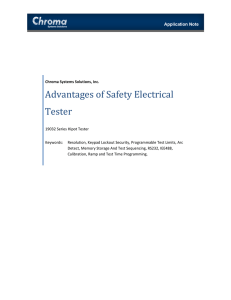Designing Hipot Test Stations
advertisement

Designing Hipot Test Stations an overview Dielectric Withstand (Hipot) testing is the most accepted method of ensuring that primary wiring and components are isolated from the safety ground. When combined with a ground continuity test to ensure integrity of the safety ground between the appliance and the building ground, the manufacturer has ensured that a fault within the appliance is unlikely and should it occur, mains power will be removed by the building breaker in a reasonable amount of time. The dielectric withstand test involves applying a high potential between current carrying primary parts and the safety ground of the appliance. The high voltages involved in this test are dangerous and the manufacturer should take steps to protect test personnel while the dielectric test is being conducted. Hipot Test Stations can be made so the operator is protected from shock. Each application differs, but the manufacturer should plan his test station with the following defenses in mind: 1. Hipot Tester Design and Building Safety Ground Issues 2. Personnel Training 3. Test station location and design 4. Non-conducting barriers 5. Interlocks 6. Periodic function checks Hipot Tester Design Hipot Equipment Design: The first line of defense is the inherent safety of the Hipot test equipment. No matter the front panel architecture, all Hipot testers have a high voltage output and a return, which is bolted to the chassis, and then bolted to the green wire of its power supply cord, and then to the building ground. This is the primary line of defense against operator shock. It is imperative that the outlet being used to power the Hipot tester be the three wire (NEMA 15P) type and be grounded in accordance with NFPA codes. Importance of the Safety Ground This is so important because we are relying on the Hipot tester to provide ground to the device being tested as well, because the device being tested is not connected to the Compliance West USA, Inc. 2120 Jimmy Durante Boulevard Suite 124 Del Mar, California 92014 USA building ground while the Hipot test is being conducted. It is the responsibility of the Hipot tester ground to keep the chassis of the device being tested at ground potential in the event of a Hipot test failure. If the Hipot tester ground is faulty, the chassis of the device being tested could be at any potential up to the voltage being output by the Hipot tester. Further, with no ground, leakage current will not flow and the Hipot tester leakage current limit may never be met, and the high potential may be available on the chassis of the device being tested for the length of the Hipot test. Finally, since the Hipot tester leakage current limit circuit will not work without a good ground, bad product will seem to be passing the Hipot test, resulting in unsafe products being shipped. Operator safety is a part of Hipot Test Design If the Hipot tester is connected to a properly grounded receptacle, the Hipot test can be conducted in a very safe manner. The operator clips a return lead to the chassis of the device being tested, and (if the Hipot tester also tests for ground continuity) the safety ground wire of the device under test is also connected to the tester. The tester checks for continuity between these two points, and if there is any resistance in the circuit, the Hipot test cannot start. This assures there is good ground provided to the device being tested. Since the return lead of the tester is essentially bolted to building ground, the chassis of the device under test is held at ground potential throughout the Hipot test. Even if a fault is found during the Hipot test, the low power available from the Hipot tester (with respect to the current carrying ability of the return lead bolted to building ground) is easily passed through the safety ground circuit with no change in potential of the chassis of the device being tested. Exposed live parts during a Hipot test If the device being tested is a complete assembly with an enclosure and provided with a NEMA 15R three-wire cordset, and a properly grounded Hipot tester is used to conduct the test, there is little chance that the operator will come in contact with high voltage. However, tests with products using a two wire polarized plug or products using a junction box for connection to building power (flying black, white and green leads instead of a power supply cord) could expose the operator to high voltage. Safety hazards while testing two-wire products Two wire products use a polarized plug to connect to building power. The return lead of the Hipot tester is connected to the chassis of the device under test, but since there is no building ground provided by the green safety ground wire, a ground continuity check cannot be conducted before the hipot test is run. If the return lead is defective or a good connection is not made with the return lead to the chassis of the device under test, then the chassis could be floating and be a shock hazard. There is no way for the hipot tester to detect this problem, so it is imperative that operators be properly trained. The equipment, especially the return lead, should also be functionally tested on a frequent basis. Compliance West USA, Inc. 2120 Jimmy Durante Boulevard Suite 124 Del Mar, California 92014 USA Safety Hazards while testing products with flying power leads In this case, high voltage is applied to the exposed white (neutral) and black (power) leads. High potential voltage is exposed while conducting this test. Operator training is necessary in this case. In addition, a fixture, guards, or an interlocked door may be necessary to protect the operator against contact with high voltage. Personnel Training Training must go past “here is the button, push it and stand back” level. In addition to being trained in proper machine operation from the Hipot tester manual, the operator should be advised of the hazards of high voltage and where the high voltage appears on the test. There are two less obvious points that are extremely important to safe Hipot test operation: 1. Proper connection of the ground lead: It is imperative that the operator make a good ground connection with the return lead of the Hipot tester. As noted above, in certain configurations the hipot tester cannot test for a good ground before applying high voltage, so safe testing is solely on the shoulders of the operator’s ability to make a good connection with the return lead. 2. High voltage and return leads are to be left connected until the Hipot meter reads zero volts. Disconnection of either lead before all voltage is discharged can leave voltage in the power supply of the device being tested. (The author recalls getting shocked due to improper bleeding after a hipot test by a television shipped overnight to California from China packed in foam.) This is a concern and the problem is not obvious. Further, it adds time to the test, and the operator is always urged to complete testing as quickly as possible, so words about this problem are warranted. Test Station Location and Design The test station should be located in a quiet area away from the normal factory flow. It should be marked and untrained personnel should be excluded. If at all possible a main power disconnect should be installed and suitably marked so anyone will be able to shut off power to the area. The bench used should be non-conductive. It is recommended that free area surround the non-conductive bench to preclude operator contact in an emergency. Compliance West USA, Inc. 2120 Jimmy Durante Boulevard Suite 124 Del Mar, California 92014 USA ESD workstations are not acceptable for the Hipot Test station. Make sure the power provided from the building source of supply is grounded in accordance with NFPA codes. This is extremely important as noted above. Arrange the equipment on the bench in a logical fashion. It may be possible to arrange the hipot tester so the operation buttons are at the far end of the test area, so the operator can operate the tester without any reason to be near the device being tested while high voltage is flowing. Non-conducting Barriers When products with exposed leads, two wire cords or when additional separation of the device being tested and the operator is desired, non-conducting barriers can be used between the operator and the device being tested. This can be something as simple as a plastic barrier which is put in place after the electrical connections have been made. It is not to be moved while the hipot test is in progress; and is moved afterwards to connect the next device under test. More elaborate non-conductive enclosures with doors can be fabricated by companies such as Industrial Automation Systems (www.industrialautomationsystems.com) for custom uses. The doors of such an enclosure can be fitted with interlocks which prevent hipot operation unless closed. Interlocks and Warning Lights Interlocks: Hipot testers can be fitted with interlocks to prevent or stop high voltage flow when the circuit is broken. Normally, two terminals are provided on the rear panel of the Hipot tester. When the tester is shipped from the factory, these terminals are shorted with a jumper. The manufacturer then places switches in line with these terminals. These switches are wired to safety switches which must be closed before the hipot tester can apply high voltage to the device being tested. In addition, properly designed interlocks will stop testing immediately when a switch is opened. Applications include placing switches on enclosure doors so the circuit closes with the door. No hipot testing can take place while the door is open, thus shielding the operator from contact with the device being tested. Another application would be two switches placed far enough apart so the operator must operate each with only one hand. Two hands on the switches means no hands in the high voltage. Compliance West USA, Inc. 2120 Jimmy Durante Boulevard Suite 124 Del Mar, California 92014 USA Warning Lights: Hipot testers can be fitted with dry contacts to allow the manufacturer to fit a light which is illuminated when high voltage is flowing to warn personnel to stay away from the area. Periodic Function Checks As noted above, it is important to make sure the hipot tester and cablesets used are functional on a frequent basis. Function testers like the Compliance West USA Model HTT-1 can test the hipot easily, and leads can be checked for continuity quite quickly. It is recommended that these checks be performed on a shift-by-shift basis, or daily if one shift is used. Proper operation of the Hipot Tester is important not only to catch problems with the devices being tested, but to provide safety to the operator. Comments and questions This information is presented to the testing community in the hope of providing some ideas to keep operators and products safe. The author invites comments, especially information pertaining to any errors or omissions. If there are any questions, he will answer to the best of his ability. Please contact Jeff Lind at the address below, email jlind@compwest.com, or call 858-481-6454. Compliance West USA, Inc. 2120 Jimmy Durante Boulevard Suite 124 Del Mar, California 92014 USA
